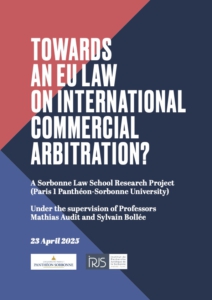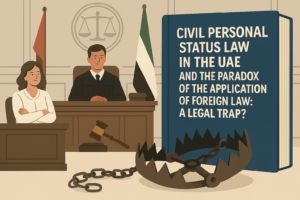Indonesian Constitutional Court on International Child Abduction
THE INDONESIAN CONSTITUTIONAL COURT DECISION REAFFIRMED PARENTAL CHILD ABDUCTION IS A CRIMINAL OFFENCE
By: Priskila Pratita Penasthika[1]
INTRODUCTION
The Indonesian Constitutional Court Decision Number 140/PUU-XXI/2023, issued on 3 September 2024, confirms that parental child abduction is a criminal offence under Article 330(1) of the Indonesian Criminal Code. Prior to this Decision, Article 330(1) of the Criminal Code was understood as a provision that could not criminalise someone for child abduction if the abduction was committed by one of the biological parents.
After 3 September 2024, through this Constitutional Court Decision, the abduction of a child by one of the biological parents, when the parent does not have custody based on a final court decision, is reaffirmed as a criminal offence.
CONSTITUTIONAL COURT DECISION
Facts
On 15 November 2023, five single mothers (Petitioners) whose children have been abducted by their ex-husbands submitted a petition to the Constitutional Court on 11 October 2023, challenging Article 330 (1) of the Indonesian Criminal Code, which states, “Anyone who, with deliberate intent, removes a minor from the authority which in accordance with the laws is assigned to him, or from the supervision of a person authorised to do so, shall be punished by a maximum imprisonment of seven years.”
The Petitioners shared a common experience: after divorcing their husbands, they were granted custody of their children through a court ruling. However, they have been deprived of this right because their ex-husband abducted their child.
The Petitioners also asserted that they had reported the ex-husband’s actions to the police under Article 330 (1) of the Criminal Code. However, in practice, the report was either dismissed or considered invalid because the police were of the view that the person who abducted the child was the biological father himself and, therefore, could not be prosecuted.
Given this background, the Petitioners believe that the phrase “anyone” (“barang siapa” in Indonesian) in Article 330(1) of the Criminal Code could be interpreted to mean that the biological father or mother of a child cannot be held accountable for the accusation of abducting their own child. Therefore, they submitted a petition to the Constitutional Court requesting a judicial review of Article 330(1) of the Criminal Code.
The Petitioners argue that the phrase “anyone” in Article 330(1) of the Criminal Code should encompass all individuals, including the child’s biological father or mother, as a legal subject. There should be no exceptions that grant absolute authority to the father or mother and exclude him or her from any legal action if he or she violates the child’s rights. Protecting children’s rights is a fundamental aspect of human rights, and the state has a responsibility to provide protection, oversight, and law enforcement to promote children’s welfare. Consequently, the state has the authority to act against parents who violate children’s rights.
Furthermore, the Petitioners request the Constitutional Court to declare that the phrase “anyone” in Article 330(1) of the Criminal Code, which was derived from the Wetboek van Strafrecht voor Nederlandsch-Indië (Staatsblad 1915 Number 732), and later enacted under Law Number 1 of 1946 on the Criminal Code in conjunction with Law Number 73 of 1958 on the Entry into Force of Law No. 1 of 1946 on the Criminal Code for the Entire Territory of the Republic of Indonesia, is unconstitutional, insofar as it is not interpreted to mean “anyone, without exception the biological father or mother of the child.”
The Decision
The Decision of the Constitutional Court Number 140/PUU-XXI/2023, which consists of nine Constitutional Judges, rejected the Petitioners’ request in its entirety.
The Constitutional Court Judges believe that Article 330(1) of the Criminal Code is an explicit and well-defined provision (expressive verbis), so there is no need to interpret it or add any supplementary meaning to it. The Judges asserted that the phrase “anyone” encompasses every individual without exception, including the biological father or mother of the child. The Court also noted that adding a new meaning to Article 330(1) of the Criminal Code, as requested by the Petitioners, could potentially restrict the scope of the legal subjects covered by that provision and other provisions in the Criminal Code that use the phrase “anyone”. This could result in legal uncertainty, according to the Judges.
In its legal deliberation, the Constitutional Court Judges referred to the United Nations Convention on the Rights of the Child (UNCRC), to which Indonesia is a state party, and its provisions are incorporated into Law Number 23 of 2002 on Child Protection, as amended by Law Number 35 of 2014 (Law on Child Protection). Furthermore, the Law on Child Protection recognises that the best interests of the child, as stipulated in the UNCRC, are a fundamental principle for child protection. According to the Official Elucidation of Law on Child Protection, the best interests of the child mean that, in all actions concerning children undertaken by the government, society, legislative bodies, and judiciary, the child’s best interest must be the primary consideration.
In cases of parental child abduction, aside from the child being the victim, the Constitutional Court recognises that the parent, who is forcibly separated from their child by the other parent, can also become a victim, particularly on a psychological level. This indicates that the psychological bond between parents and their biological children should not be severed, emphasising that the child’s best interests must take precedence. In this context, the Constitutional Court Judges emphasise that criminalising one of the child’s biological parents who breaches the provisions of Article 330(1) of the Criminal Code should only be considered as a last resort (ultimum remedium).
In another part of its Decision, the Constitutional Court addressed the issue of the Petitioners whose reports were rejected by the police. The Constitutional Court Judges stated that they had no authority to assess this matter. However, they affirmed in the Decision that law enforcement officers, especially police investigators, should have no hesitation in accepting any report concerning the application of Article 330(1) of the Criminal Code, even if it involves the child’s biological parents. This is because the term “anyone” includes every individual without exception, including, in this case, the child’s biological father and mother.
The Constitutional Court concluded that Article 330(1) of the Criminal Code provides legal protection for children and ensures fair legal certainty as outlined in the 1945 Constitution of the Republic of Indonesia. Therefore, the Court states that the Petitioners’ request is rejected in its entirety.
Dissenting Opinion
The nine Constitutional Judges did not reach a unanimous decision. Judge Guntur Hamzah expressed his dissenting opinion, arguing that the Constitutional Court should have partially granted the Petitioners’ request.
Judge Hamzah views the Petitioners’ case as also involving the enforcement of a norm that breaches the principles of justice, the constitution, and human rights. Due to numerous cases of parental child abduction, often committed by biological fathers, Judge Hamzah believes it is appropriate for the Constitutional Court to act as the defender of citizens’ constitutional rights in this matter. This aims to safeguard the constitutional rights of biological mothers who hold custody, whether naturally or legally granted by the court, from acts of child abduction or forced removal by biological fathers. It not only ensures legal certainty but also offers reassurance to both the child and the parent who holds the legal custody rights.
Judge Hamzah is of the opinion that the Constitutional Court should have partially granted the Petitioners’ request by inserting the phrase “including the biological father/mother” into Article 330(1) of the Criminal Code. This would have made Article 330(1) of the Criminal Code to read, “Anyone who, with deliberate intent, removes a minor from the authority which in accordance with the laws is assigned to him, including his biological father/mother, or from the supervision of a person authorised to do so, shall be punished by a maximum imprisonment of seven years.”
REMARKS
It is worth noting that Law Number 1 of 2023 on the Criminal Code (New Criminal Code) was approved by the Indonesian House of Representatives on 2 January 2023. The New Criminal Code will come into effect on 2 January 2026. There are no significant changes regarding the concept of child abduction in the New Criminal Code. Article 452(1) of the New Criminal Code is equivalent to Article 330(1) of the current Criminal Code. Article 452(1) of the New Criminal Code states: “Every person who removes a Child from the authority which in accordance with the statutory regulations is assigned to him or from the supervision of a person authorised to do so, shall be punished by a maximum imprisonment of 6 (six) years or a maximum fine of category IV.”
It is quite unfortunate that there has been no shift in the perspective towards parental child abduction cases in Indonesia. In early 2023, Indonesian lawmakers, as indicated in Article 452(1) of the New Criminal Code, still regard parental child abduction cases primarily from a criminal perspective. This stance is later reaffirmed in 2024 by the Court, as stated in the Constitutional Court Decision Number 140/PUU-XXI/2023.
Although the Constitutional Court Judges, in their Decision, recognise the psychological bond between parents and the child as part of the child’s best interests and acknowledge that criminalising a parent over child abduction is a last resort, parental child abduction is still viewed from a criminal perspective. Consequently, this Constitutional Court Decision does not provide an effective solution. The five petitioners remain unable to access their abducted children because they do not know their children’s whereabouts or how to contact them.
The Constitutional Court Judges also hold conflicting views in their deliberations. On one hand, they acknowledge that the psychological bond between parents and a child must be prioritised as part of the child’s best interests. On the other hand, they affirm the provision of Article 330(1) of the Criminal Code, which permits the criminalisation and imprisonment of the parent who commits child abduction, albeit as a last resort. It seems that the judges overlooked the possibility that criminalising and imprisoning the parent involved in child abduction could also harm the child’s best interests, as it would deprive the child of access to that parent.
It is also regrettable that none of the Judges or the expert witnesses involved in the proceedings mentioned the HCCH 1980 Convention on the Civil Aspects of International Child Abduction (HCCH 1980 Child Abduction Convention), which provides a perspective on parental child abduction from its civil aspects. Consequently, the procedures for returning the wrongfully removed child to their habitual residence—while safeguarding access rights and prioritising the child’s best interests as stipulated by the Convention—remain unfamiliar and unexplored in Indonesia.
The Constitutional Court Decision Number 140/PUU-XXI/2023, which considers parental child abduction from its criminal aspect, reveals a legal gap in Indonesian law that can only be filled in by the HCCH 1980 Child Abduction Convention. The Convention could serve as an instrument providing civil measures in cases of parental child abduction in Indonesia and promote a more effective resolution by ensuring the child’s prompt return without depriving access to either parent. In other words, Indonesia’s accession to the Convention has become more urgent to ensure that the child’s best interests, as recognised by Indonesian Law on Child Protection, are adequately protected.
Recognising that many adjustments within Indonesian laws and regulations will still be necessary, the Author of this article has long hoped that Indonesia will eventually accede to the HCCH 1980 Child Abduction Convention, hopefully sooner rather than later.
[1] Assistant professor in private international law at the Faculty of Law, Universitas Indonesia.





